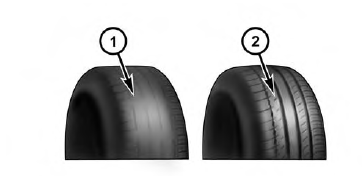Jeep Cherokee (KL): Tire Spinning. Tread Wear Indicators. Life Of Tire
When stuck in mud, sand, snow, or ice conditions, do not
spin your vehicle's wheels above 30 mph (48 km/h) or
for longer than 30 seconds continuously without stopping.
Refer to "Freeing A Stuck Vehicle" in "What To Do In
Emergencies" for further information. WARNING! Fast spinning tires can be dangerous. Forces generated
by excessive wheel speeds may cause tire damage
or failure. A tire could explode and injure someone.
Do not spin your vehicle's wheels faster than
30 mph (48 km/h) for more than 30 seconds continuously
when you are stuck, and do not let anyone near
a spinning wheel, no matter what the speed. Tread wear indicators are in the original equipment tires
to help you in determining when your tires should be
replaced. 1 - Worn Tire 2 - New Tire These indicators are molded into the bottom of the tread
grooves. They will appear as bands when the tread depth
becomes a 1/16 of an inch (1.6 mm). When the tread is
worn to the tread wear indicators, the tire should be
replaced. Refer to "Replacement Tires" in this section for
further information. The service life of a tire is dependent upon varying
factors including, but not limited to: WARNING! Tires and the spare tire should be replaced after six
years, regardless of the remaining tread. Failure to
follow this warning can result in sudden tire failure.
You could lose control and have a collision resulting
in serious injury or death. Keep dismounted tires in a cool, dry place with as little
exposure to light as possible. Protect tires from contact
with oil, grease, and gasoline.Tire Spinning
Tread Wear Indicators

Tire TreadLife Of Tire
Other materials:
Description and operation
Charging system
DESCRIPTION
The charging system consists of:
Generator
Electronic Voltage Regulator (EVR) circuitry
within the Powertrain Control Module (PCM)
Ignition switch (refer to Group 8D, Ignition System
for information)
Battery (refer to Group 8A, Batte ...


